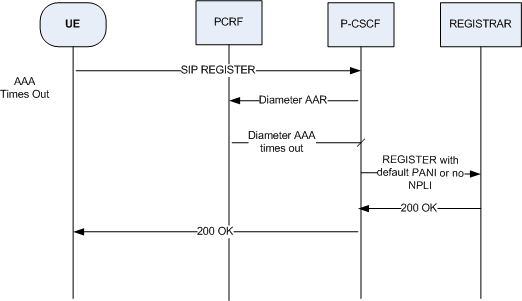Network Provided Location Information During Registration
For most cases, location information is relevant at the time of the session request. However, Network Provided Location Information (NPLI) upon REGISTER is required for some Authorization-Authentication Requests (AAR) and Authorization-Authentication Answers (AAA).
The access awareness feature in the Serving Call Session Control Function (S-CSCF) uses the P-Access-Network-Info header in the initial REGISTER request for selecting the registration and authentication profile. This in turn depends on the access class of the IP Connectivity Access Network (IP-CAN) being used by the user equipment. For that reason, the Oracle Communications Session Border Controller Proxy Call Session Control Function (P-CSCF) requires that the Authorization-Authentication Answer (AAA) from the Policy Charging and Rules Function (PCRF) to contain the Radio Access Technology (RAT-type) Attribute Value Pair (AVP). It uses this information to populate the P-Access-Network-Info (PANI) header in the forwarded REGISTER request according to that value. The npli-upon-register parameter must be set to enabled for this behavior.
Example Call Flows
When user equipment (UE) registers for the first time the Oracle Communications Session Border Controller buffers the incoming REGISTER and sends an AAR to the PCRF. The AAA from the PCRF contains a 3GPP-User-Location Info AVP: IP-CAN-Type and RAT-Type AVP. The Oracle Communications Session Border Controller uses those AVPs to populate a PANI header in the REGISTER that is forwarded to the Registrar.
Figure 18-1 Initial Registration Flow

If a registration refresh is received before the half time of the registration expiration interval then the registration cache is not updated and the Oracle Communications Session Border Controller sends a 200 OK to the UE. No AAR is sent to the PCRF.
Figure 18-2 Re-Register before Half Time of Expiration

If a registration refresh is received after the half time of the registration expiration interval or if any registration information is changed then the Oracle Communications Session Border Controller will send an AAR to the PCRF. The AAA response from the PCRF contains a 3GPP-User-Location Info AVP: IP-CAN-Type and RAT-Type AVP. The Oracle Communications Session Border Controller will use the AVPs to populate a PANI header in the REGISTER that is forwarded to the registrar.
Figure 18-3 Re-Register after Half Time of Expiration

De-Register
When an endpoint removes all of its contacts from registration by sending a REGISTER with expires=0, the Oracle Communications Session Border Controller will buffer the incoming REGISTER and send an AAR to the PCRF. The AAA response from the PCRF contains a 3GPP-User-Location Info AVP: both IP-CAN-Type and RAT-Type AVP. The Oracle Communications Session Border Controller will use the AVPs to populate a PANI header in the REGISTER that is forwarded to the Registrar. After the Oracle Communications Session Border Controller receives the 200 OK response to the REGISTER, it will send a STR message to the PCRF to terminate the session.
Figure 18-4 De-Registration

If the AAA is not received before the timeout, the AAA returns with an error, or the AAA is missing the required location information, then the Oracle Communications Session Border Controller will search the NPLI cache for cached location information to construct the PANI header to forward to the Registrar. If there is no cached location information, then the default-location-string configuration parameter will be used to create the PANI header. The default-location-string is obtained from the configuration in either the Realm or the SIP interface, with the Realm taking precedence; in both cases the value will be taken from the Access Realm. If the default-location-string is not set, then the REGISTER will be forwarded to the core without a PANI header.
Figure 18-5 AAA Timeout/Error or AAA does not have Location Information

Register with IMS-AKA Enabled
If the IP Multimedia Subsystem Authentication and Key Agreement (IMS-AKA) is enabled then when a UE registers for the first time, the Oracle Communications Session Border Controller will forward the unprotected REGISTER to the Registrar without triggering an AAR. The Registrar will reply with a 401 Authentication Required response. The UE and the PCRF will use the information in the 401 response to create a secure channel. The UE will then send a protected REGISTER that will trigger the Oracle Communications Session Border Controller to send an AAR to the PCRF. The AAA response from the PCRF contains a 3GPP-User-Location Information AVP: both IP-CAN-Type and RAT-Type AVP. The Oracle Communications Session Border Controller will use those AVPs to populate a PANI header in the REGISTER that is forwarded to the registrar.
Figure 18-6 Register with IMS-AKA Enabled




